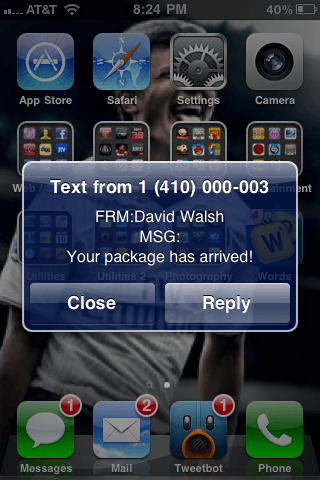Convert NodeList to Array
Now that most browsers have implemented querySelectorAll, the native selectorEngine, many framework-dependent developers are getting a rude awakening when dealing with the result of QSA calls: the NodeList object. NodeLists are array-like but don't feature many of the methods provided by the Array, like forEach, map, filter, etc. JavaScript does, however, provide a very simple way to convert NodeLists to Arrays:
var nodesArray = Array.prototype.slice.call(document.querySelectorAll("div"));
The result of the code above is a true Array object containing all of the nodes returned by the QSA. You could even make the code shorter with this alternative:
var nodesArray = [].slice.call(document.querySelectorAll("div"));
Both snippets will give you an Array for which you can iterate over and do all those other awesome array things!
![Regular Expressions for the Rest of Us]()
Sooner or later you'll run across a regular expression. With their cryptic syntax, confusing documentation and massive learning curve, most developers settle for copying and pasting them from StackOverflow and hoping they work. But what if you could decode regular expressions and harness their power? In...
![Send Text Messages with PHP]()
Kids these days, I tell ya. All they care about is the technology. The video games. The bottled water. Oh, and the texting, always the texting. Back in my day, all we had was...OK, I had all of these things too. But I still don't get...
![MooTools Wall Plugin]()
One of the more impressive MooTools plugins to hit the Forge recently was The Wall by Marco Dell'Anna. The Wall creates an endless grid of elements which can be grabbed and dragged, fading in elements as they are encountered. Let me show...
![Highlighter: A MooTools Search & Highlight Plugin]()
Searching within the page is a major browser functionality, but what if we could code a search box in JavaScript that would do the same thing? I set out to do that using MooTools and ended up with a pretty decent solution.
The MooTools JavaScript Class
The...





David does the second example not create a new object allocation that would require being garbage collected? I’d say it’s only a good method for start-up tasks but nothing that is running often, running in a loop or animation.
Hmm… Time to use stuff like underscore js perhaps?
Also, you can really simply iterate over a node list with native JS anyways.
var nodes = document.querySelectorAll('div') , i , node; for (i in nodes) { node = nodes[i]; console.log(node); }Or, as per my suggestion, use some underscore:
_.each(document.querySelectorAll('div'), function bringMeThatDiv (div) { console.log(div); });It’s never a good idea to use
for...into cycle through indexed collections. It’s way slower than the classic for:for (var i = 0, n = nodes.length; i < n; i++) { ... }But the whole point of having an Array instead of a
NodeListis to get all those goodies likemapandforEach, as stated in the post. Callbacks are slow, but if you care about performances, then don't use for…in.Doesnt work on old IEs. Though it’s less and less relevant
IE8 still will be relevant for the next couple of years.
Is there a difference in performance using this vs
Array.prototype.slice.call(nodelist)It seems the latter would be slightly more performant, as I thought an array literal allocated memory, and the above doesn’t.
Yes, indeed, using Array.prototype is slightly faster… but takes longer to type!
It’s just that. A good garbage collector will free the memory right after the statement.
If performances aren’t vital, you can go for [].
Why are we using
Array.prototype.slice……. And not simplyArray.slice…?Because it doesn’t work that way?
In my opinion, using a raw
[]un-intuitive and code-smelly. It doesn’t clearly communicate the intent of the code unless the developer reading it happens to have read a blog post saying “Hey, typing [] is shorter than typing Array.prototype”. And since when is shorter superior? I don’t think you should sacrifice any semantic meaning for the sake of wiggling your fingers a little less. The time you save by typing[]is completely insignificant compared to the potential time you make the next person waste trying to figure out your cool shortcuts.Array.prototype.slicepreserves the meaning of the code and it’s google-able. And if you really are a slow typist, how aboutconst slice = Array.prototype.slice;? How often are you really typing this, anyways?If you’re curious about performance have a look at the jsperf test Convert Nodelist to Array
Here’s the compact code (102 bytes) that allows not only a global , but also a local QSA (to find all the descendants of a certain element)
Element.prototype._=_=function(s){return[].slice.call((this==self?document:this).querySelectorAll(s))}Note: I tried to use
[].concatjust like[].slicewhich will work appropriately with arrays but not aNodeList.[].concatconcats the elements of the passed array and does not create another dimension in the returned array which is what I was getting with a NodeList and was causing my error. So do not confuseNodeListswith Arrays.With Babel, life gets even a bit easier:
const buttons = document.querySelectorAll('button'); [...buttons].forEach(initButton);or for single use stuff, inline all the stuffs:
[...document.querySelectorAll('button')].forEach(initButton);This probably works on Babel, but please don’t do that or advice others to do that. NodeList doesn’t have the Iterator symbol, and thus it can’t work with the standard. If you run your code in latest Chrome for example, it will throw an error of
. The fact that it works on Babel, doesn’t mean it is correct.
[...document.querySelectorAll("button")]works perfectly for me in chromeHow to get the value of this array? Since I follow yours what I get is the object instead of value.
Why not just use ES6?
let products = Array.from(document.querySelectorAll('.product'));Why not use
Array.apply?Array.apply([], document.querySelectorAll('div')); //or Array.apply(null, document.querySelectorAll('div'));